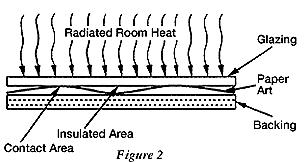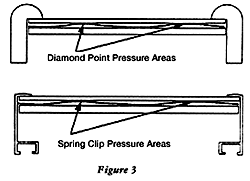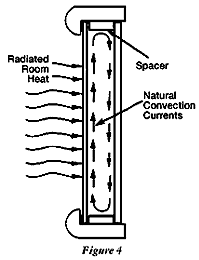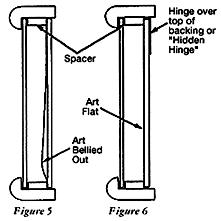Jan 20th 2016
Why Paper Art Buckles in a Frame
Why Paper Art Buckles In A Frame
How To Prevent buckling of paper art in a picture frame. Basic ideas on buckling, wet-spots, image transfer and adhesion to the glass in a frame.
This is a compilation of thoughts and theories regarding buckling, or cocking, of paper art in a picture frame. It includes some basic ideas on how to prevent buckling, wet-spots, image transfer and adhesion to the glass in a frame. Understanding the following theories will give you the information necessary to design framing projects that will display paper art properly.
Paper expands and contracts with changes in temperature and humidity. It will generally change dimensionally "across" the grain of the paper more than "with" the grain.
Paper art placed in direct contact with the glazing will respond to humidity changes around the edges before the center area. As the paper around the edge expands and contracts, the edges begin to show signs of buckling (Fig. 1).

Glass transfers heat better than air does. Paper in contact with the glass will experience heat changes rapidly. Whereas paper slightly away from the glass will be insulated by the glass evenly across the entire face of the paper. Thereby creating differences in heat (and relative humidity) in localized areas on the paper (Fig. 2).

When the room is hot, the areas in contact with the glass get slightly drier and the areas away from the glass stay humid. This slight difference in humidity content will make the paper buckle. During severe temperature changes humidity may condense on the inside of the glazing and leave water marks on the areas of paper in tight contact with the glazing. Because of this, localized pressure from spring clips, diamond points, etc. will have a different humidity content than areas slightly spaced away from the glass. This humidity difference around the edge of the paper causes buckling between the pressure points (Fig. 3).

The natural convection currents in the space between the art and the glazing will help maintain an even humidity level over the entire face of the art. The art, as well as mats and backing, will still expanded and contract but if allowed to move freely, buckling will be minimal (Fig. 4).

In time, a large piece of paper art standing "on end" will belly out near the bottom (Fig. 5). The same paper "hanging" from hinges at the top will be pulled taut by gravity and will hang flat (Fig. 6).

Even with proper air space any slight pressure around the edge of the art will hinder expansion and contraction and cause buckling. In wood frames use minimal pressure when installing diamond points or brads (Fig. 7). In metal frames, bond strips of mat board, or foam core to the edge of the backing rather then using springs clip (Figs. 8 & 9). Leave a little space to insure the art won't be pinched.
Mold will not grow readily where there is good air circulation. Providing sufficient air space between the art and the glazing will greatly inhibit mold growth.

Image or ink transfer, adhesion to the glazing, and "wet spots" are greatly reduced or stopped with sufficient air space between the art and glazing. A glossy print or photograph placed in direct contact with the glazing will appear "wet" in spots of localized pressure due to a difference in refraction at that point. Humidity condensing at these points may cause a photograph to actually adhere to the glazing. Some inks and paints will adhere to glazing if left in contact for long periods.
Prints with large inked and non-inked areas have inherent buckling problems because the inked areas are somewhat sealed against humidity absorption compared with the non-inked areas. Slight differences in humidity across the face of a print will cause buckling.
Japanese calligraphy pieces have an inherent problem with buckling in that most are painted very heavily just in the central area of the paper. This tends to shrink the paper just in the center leaving the outer area buckled to start with.
Paper that's already buckled doesn't get flat just because it gets framed. These problems should be discussed with the customer up front. A good way of demonstrating how much a print is buckled is to place the print under a piece of glass on a flat surface. The buckling will show up very well and you can demonstrate to your customer how localized pressure, like spring clips, won't make the print lay flat.
It's part of your job as a "Professional" framer to explain to your customer why you're leaving everything a little loose in the frame. Rattling beats buckling.
There is a certain humidity level in all the materials put into a frame during fitting. This level changes, sometimes very rapidly, with changes in room temperature or humidity. Humid air will leak around the edges of the glazing as well as being adsorbed through the backing materials. If the art will be subjected to rapid changes in either heat or humidity, you should put a vapor barrier in back of the backing board and and seal the whole package, from the glazing to the vapor barrier, with a good quality tape. This will slow down the rapid change in humidity and give the art time to expand or contract gradually.


